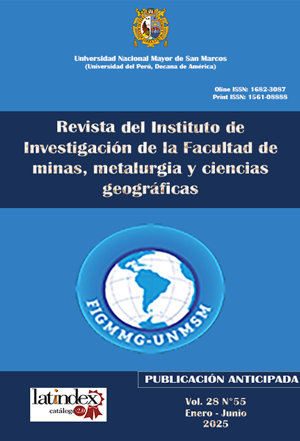Application of unmanned aerial vehicle for risk identification in construction projects
DOI:
https://doi.org/10.15381/iigeo.v28i55.26728Keywords:
unmanned Aerial Vehicle, Drones, Autonomous Flight, Hazard and Risk Identification, Aerial PhotographyAbstract
This article was developed with the purpose of generating new knowledge about the use of unmanned aerial vehicles (drones) in the identification of occupational risks in construction projects in Peru. This work seeks to demonstrate the importance of unmanned aerial vehicles in preventive management, generating privileged aerial information from various work areas in reduced time and producing added value in occupational risk management compared to traditional methods.
The unmanned aerial vehicle generates valuable information that allows different work areas to be examined in real time and to promptly detect substandard acts and conditions that may affect workers. Currently in Peru, there is little information on the use of unmanned aerial vehicles in occupational risk management; Therefore, this study has revealed favorable results on the relationship that exists between the unmanned aerial vehicle and risk identification. This correlation is supported by the statistical tests carried out, which establish that autonomous flight, panoramic views and Field inspections carried out by the drone are essential to identify occupational risks in construction projects.
References
Adames Cepeda, J. L. (2020). Utilización de sistemas aéreos no tripulados (UAS) en el sector de la construcción. Tesis. Obtenido de http://hdl.handle.net/2117/341623
Barajas Hernández, J. (2021). Aplicaciones de los drones en la industria de la construcción. NEXTIA, 6, 5-16. https://revistas.uvp.mx/index.php/nextia/article/view/65/68
Bastos Costa, D., Irizarry, J., Sampaio Álvares, J., & Santos de Melo, R. (2017). Applicability of unmanned aerial system (UAS) for safety inspection on construction sites. Safety Science, 98, 174-185. https://doi.org/10.1016/j.ssci.2017.06.008
Campo Tapia, G. A., Moreno Muñetón, E., Nevito Sánchez, L., & Ramírez Gutiérrez, D. (2020). Uso de drones para prevenir accidentes de trabajo en trabajadores de la Gobernación de Antioquia. https://hdl.handle.net/20.500.12962/724
Chica Villalba, D. E. (2021). Evaluación tecnológica de vehículo aéreo no tripulado (dron) para el control de riesgos laborales en la construcción de un túnel en la ciudad de Cariamanga - Ecuador. http://repositorio.ug.edu.ec/handle/redug/58944
Decreto Supremo n.° º 005-2012-TR. Reglamento de la Ley n.° 29783, Ley de Seguridad y Salud en el Trabajo (25 de abril de 2012). https://diariooficial.elperuano.pe/Normas/obtenerDocumento?idNorma=38
Shi Zhou, M. (2018). Aplicaciones de sistemas aéreos no tripulados en la construcción: una revisión sistemática. esmerald insight, 18(4), 453-468. https://doi.org/10.1108/CI-02-2018-0010
Sansón, J. (2019). El uso de drones en la industria de la construcción conduce a la integración en el plan de estudios actual de tecnología de ingeniería civil y de la construcción. Documento presentado en 2019 CIEC (pág. 5). Nueva Orleans, LA: ASEE PEER. https://peer.asee.org/31517
Solórzano Bákit, M. C., Porras Bolaños, E., Jiménez Jiménez, J., & Méndez Flores, M. (2020). Drones y tecnología como elementos claves en la gestión de procesos constructivos: una revisión de literatura. Technology Inside, 6, 1-15. https://cpic-sistemas.or.cr/revista/index.php/technology-inside/article/view/64
Solorzano Plaza, H. A. (2022). Prevención de riesgos laborales eléctricos a través de un dron termográfico inteligente para CNEL-Esmeraldas. Sapienza: Revista Internacional de Estudios Interdisciplinarios, 3, 1282–1336. https://journals.sapienzaeditorial.com/index.php/SIJIS/article/view/372
Downloads
Published
Issue
Section
License
Copyright (c) 2025 Ronald Antonio Julca Alcántara, Lucila Del Carmen Vallejo Romo

This work is licensed under a Creative Commons Attribution 4.0 International License.
AUTHORS RETAIN THEIR RIGHTS:
a. Authors retain their trade mark rights and patent, and also on any process or procedure described in the article.
b. Authors retain their right to share, copy, distribute, perform and publicly communicate their article (eg, to place their article in an institutional repository or publish it in a book), with an acknowledgment of its initial publication in the Rev. Inst. investig. Fac. minas metal cienc. geogr.
c. Authors retain theirs right to make a subsequent publication of their work, to use the article or any part thereof (eg a compilation of his papers, lecture notes, thesis, or a book), always indicating the source of publication (the originator of the work, journal, volume, number and date).






